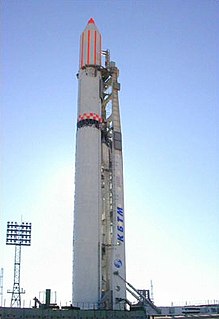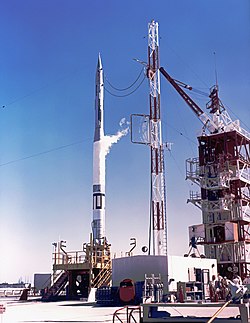
The Fairchild SM-73 was a sub-sonic, jet-powered, ground-launched decoy cruise missile.

Strela is a Russian orbital carrier rocket, derived from the Soviet/Russian UR-100NU missile. It conducted its maiden test launch on 5 December 2003, carried its first functional payload on 27 June 2013, and a second one on 19 December 2014.

Site 45 at the Baikonur Cosmodrome is a launch site used by Zenit rockets. It consists of two pads, one of which is still in use. It has been the launch site for all Soviet and Russian government Zenit launches, along with a commercial launch conducted for Globalstar in 1998, and continuing commercial launches under the Land Launch programme. The main pad at the site is area 45/1, which was completed in 1983 following five years of construction. A second pad, area 45/2, was completed in 1990, but was destroyed by a launch failure in the same year.
Launch Complex 10 (LC-10) at Cape Canaveral Air Force Station, Florida was a launch pad used by SM-64 Navaho missiles, and later Jason sounding rockets and the Alpha Draco research missile. It was located north of Launch Complex 17, where Launch Complexes 31 and 32 are now located. The pad consisted of a small concrete launch structure with an elevated launch pedestal and built-in flame trench, centered on a small oval-shaped concrete pad.

Launch Complex 11 (LC-11) at Cape Canaveral Air Force Station, Florida, is a launch complex used by Atlas missiles between 1958 and 1964. It is the southernmost of the launch pads known as Missile Row. When it was built, it, along with complexes 12, 13 and 14, featured a more robust design than many contemporary pads, due to the greater power of the Atlas compared to other rockets of the time. It was larger, and featured a concrete launch pedestal that was 6 metres (20 ft) tall and a reinforced blockhouse. The rockets were delivered to the launch pad by a ramp on the southwest side of the launch pedestal.

Launch Complex 12 (LC-12) at Cape Canaveral Air Force Station, Florida was a launch pad used by Atlas rockets and missiles between 1958 and 1967. It was the second-most southern of the pads known as Missile Row, between LC-11 to the south and LC-13 to the north. Along with Complexes 11, 13 and 14, 12 featured a more robust design than many contemporary pads, due to the greater power of the Atlas compared to other rockets of the time. It was larger, and featured a concrete launch pedestal that was 6 metres (20 ft) tall and a reinforced blockhouse. The rockets were delivered to the launch pad by means of a ramp on the southwest side of the launch pedestal.
Site 132, also known as Chusovaya, is a launch complex at the Plesetsk Cosmodrome in Russia, used by Kosmos carrier rockets. It consists of a two launch pads, Site 133/1, which is active, and Site 133/2 which is not.
Site 131, also known as Voskhod, was a launch complex at the Plesetsk Cosmodrome in Russia, used by Kosmos carrier rockets and R-14 missiles. It consisted of a single launch pad, which was used between 1967 and 1969.
Site 41, also known as Lesobaza and SK-1, was a launch complex at the Plesetsk Cosmodrome in Russia. It consisted of a single pad, Site 41/1, and was used by R-7 derived rockets between 1959 and 1989.
Site 16, also known as SK-2, is a launch complex at the Plesetsk Cosmodrome in Russia. It consists of a single pad, Site 16/2, and has been used by R-7 derived rockets since 1960.

Site 43, also known as SK-3 and SK-4, is a launch complex at the Plesetsk Cosmodrome in Russia. It consists of a two pads, Sites 43/3 and 43/4, and has been used by R-7 derived rockets since the early 1960s.

Launch Complex 16 (LC-16) at Cape Canaveral Air Force Station, Florida is a launch complex built for use by LGM-25 Titan missiles, and later used for NASA operations before being transferred back to the US military and used for tests of MGM-31 Pershing missiles. Six Titan I missiles were launched from the complex between December 1959 and May 1960. These were followed by seven Titan II missiles, starting with the type's maiden flight on March 16, 1962. The last Titan II launch from LC-16 was conducted on May 29, 1963.

Launch Complex 18 (LC-18) is a launch complex at the Cape Canaveral Air Force Station, Florida that was active during the late 1950s and early 1960s. It was used by Viking, Vanguard, Thor and Scout rockets. The complex consists of two launch pads, LC-18A, which was originally built by the US Navy for the Vanguard rocket, and LC-18B, which was originally by the US Air Force used for tests of the PGM-17 Thor missile.
Kosmos 19, also known as DS-P1 No.3 was a prototype radar target satellite for anti-ballistic missile tests, which was launched by the Soviet Union in 1963 as part of the Dnepropetrovsk Sputnik programme. Its primary mission was to demonstrate the necessary technologies for radar tracking of spacecraft, which would allow future satellites to function as targets.
Kosmos 25, also known as DS-P1 No.4 was a prototype radar target satellite for anti-ballistic missile tests, which was launched by the Soviet Union in 1964 as part of the Dnepropetrovsk Sputnik programme. Its primary mission was to demonstrate the necessary technologies for radar tracking of spacecraft, which would allow future satellites to function as targets.
Launch Complex 22 (LC-22) at Cape Canaveral Air Force Station, Florida is a launch complex that was used for horizontal launches of cruise missiles between 1957 and 1960. It consisted of two launch rails, from which XSM-73 Bull Goose and MGM-13 Mace missiles were tested. Unlike the other Mace launch site, Launch Complex 21, no concrete structure was built to enclose the launch rails when it was converted to launch the Mace in 1959. This earned the pad the nickname of "the softsite".
Launch Complex 1, also known as Pad 1, is a Long March launch complex at the Taiyuan Satellite Launch Centre. It consists of a single launch pad, which has been used by Long March 2C, Long March 4A, Long March 4B and Long March 4C carrier rockets. Until the activation of Launch Complex 2 in 2008, it was the only launch site for Long March 4 rockets. Long March 4 launches have since also occurred from Jiuquan.
Site 110 at the Baikonur Cosmodrome is a launch facility which was used by the N1 rocket during the late 1960s and early 1970s, and by the Energia rocket during the 1980s.

From 1960 to 1988 there were Pershing missile launches for testing from various sites in the US. The systems included the Pershing 1 Field Artillery Missile System, the Pershing 1a Field Artillery Missile System and the Pershing II Weapon System. Initial launches were from what is now the Eastern Range at Cape Canaveral, Florida using Launch Complex 30A using the dismounted erector launcher. Later launches were from the full transporter erector launcher (TEL). Further launches were conducted at White Sands Missile Range (WSMR) using tactical equipment. The Pershing 1 and 1a had a range of 740 kilometres (460 mi), thus launches were from various subinstallations into WSMR. The two-stage Pershing II had a range of 1,770 kilometres (1,100 mi), thus launches at WSMR used a single-stage missile with two-stage launches at Cape Canaveral.

Cape Canaveral Air Force Station Launch Complex 47 is a launch pad for sounding rockets located at the north end of Cape Canaveral Air Force Station, Florida. It is the smallest launch complex used in the air force station. The complex features a small blockhouse a few yards from the pad, containing vehicle-specific hardware. Between 1984 and 2008, 531 sounding rockets were launched from pad 47. All weather rocket operations were relocated here from Launch Complex 43 in 1984 in order to make room for the construction of Launch Complex 46.










